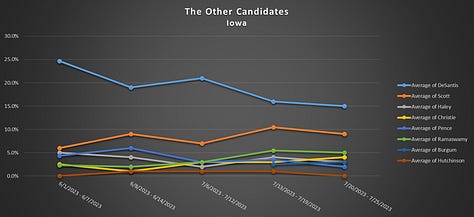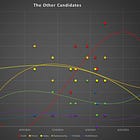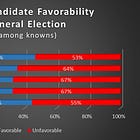DeSantis Losing Ground as Scott Maintains Momentum
Reviewing Polls of Early 2024 GOP Primary States
The 2024 GOP Primary slate kicks off with the Iowa Caucus in 174 days.1 I recently looked at the polls in Iowa. I mentioned that the early primary states are vital for lesser-known candidates to get their message out. At the time, there was a clear separation between Donald Trump, Ron DeSantis, and the rest of the field.
But soon after Iowa’s caucus, New Hampshire is set to hold the nation’s first primary.2 South Carolina should be soon to follow.3 So, let’s take another look at the polls, and this time expand our focus to all three of the early primary states: Iowa, New Hampshire, and South Carolina.4
Trump Still Holds Significant Lead but the Field Is Gaining Ground
Averaging the polls of Iowa, New Hampshire, and South Carolina respondents by week, you can see that Donald Trump still holds a significant lead over the rest of the candidates. The most recent surveys show him sitting at about 42%, on average, in the three early states. No other candidate averages more than 15%.
With that said, it does appear that Donald Trump is losing ground, even if ever-so-slightly, against the field. When you plot Trump’s numbers against the percentage of respondents who either said they were undecided or support another candidate, you can see that Trump’s numbers have slightly declined over the last two months. Trump seems to be settling in at around 40% of the vote, which leaves nearly 60% of the primary voters out there for another candidate to consolidate.
DeSantis is Falling Quickly in with the Rest of the Field
There have been a lot of negative headlines for DeSantis lately.5 In fact, DeSantis is laying off campaign staff in hopes of “resetting” the campaign.6 Looking at the polls, it’s easy to see why DeSantis’s campaign is concerned. Back in the beginning of June, DeSantis held a commanding advantage over the rest of the field attempting to challenge Trump. His numbers were up around 25% while nobody else (aside from Trump) was above around 6%. At the time, the gap between him and Trump (about 16%) was less than the gap between him and the next closest candidate (about 19%).
As you can see in the chart above, his lead over the rest of the field has nearly disappeared. His numbers have crashed over the last month and a half. As it stands today, DeSantis is averaging about 15% in the early states (a drop of 10% from where he stood in early June). Meanwhile, his competition is gaining ground. Tim Scott has actually risen to 8-10% in the early state polls. As a result, the gap between DeSantis and Trump (about 27%) now dwarfs the gap between DeSantis and Scott (about 7%).
It no longer seems reasonable to consider DeSantis in a separate tier from the rest of the field challenging Trump.
Tim Scott is Gaining Ground in all Three Early States
With DeSantis losing momentum, it appears Tim Scott is best positioned to capitalize on his fall. That’s because Tim Scott seems to have fairly broad appeal across all three early states. The most recent polls show that Scott is sitting around 9-10% in Iowa (up about 3-4% from where he was in early June), 8% in New Hampshire (up 3%), and 10% in South Carolina (holding steady in his home state). No other candidate (other than Trump and DeSantis) is above 4% in all three states.



I recently wrote about Scott’s strong favorability ratings and noted that they indicated a lot of upward potential for Scott as he got his message out. Well, it appears that in these early states, where his campaign is spending the vast amount of its resources doing just that, he is indeed gaining support.
If DeSantis’s campaign continues its decline, it will be very interesting to see what Tim Scott can do with the additional attention as voters seek out another challenger for Trump.
Vivek Ramaswamy’s National Support Isn’t Reflected in State Polls
A name that I haven’t mentioned in this article is Vivek Ramaswamy. He has gotten some recent headlines based on his increasing support in national polls.7 In fact, Ramaswamy is averaging around 6-7% in the most recent national polls, which puts him in a firm third behind DeSantis (who is sitting at a little under 15% nationally). Interestingly, this is well ahead of Tim Scott who only averages about 3-4% in national polls. Mike Pence and Nikki Haley are also ahead of Tim Scott in national polls.
Ramaswamy’s national support, however, is not reflected in the early states where he trails Tim Scott in all three states by significant margins (averaging about half of Scott’s numbers in all three). This probably reflects Ramaswamy’s lack of campaign strength on the ground in those states. Ramaswamy’s campaign seems to be more based on viral videos on social media and less like a traditional campaign. We will see how well that can be sustained as the primary season approaches.
The date is not technically set yet, but is likely to be the week after the Iowa caucus. https://www.nbcnews.com/politics/2024-election/iowas-gop-caucus-date-set-timing-new-hampshires-primary-not-simple-rcna94575
Note: Technically, Nevada is also set to hold a primary in early February, but the state GOP has indicated they may boycott the primary, opting instead to hold a caucus later in the primary calendar. https://en.wikipedia.org/wiki/2024_Nevada_Republican_presidential_nominating_contests
Likely in part because of this uncertainty, there is not as much polling data out of Nevada and the candidates do not seem to be expending as much time and energy there as the other early states. With that in mind, I chose to focus my analysis on Iowa, New Hampshire, and South Carolina.
https://www.nbcnews.com/politics/2024-election/ron-desantis-campaign-finances-flashing-warning-signs-rcna94108; https://apnews.com/article/desantis-trump-republican-president-reset-fundraising-cd06b81f9493ef369b382413ca3e4fdd; https://www.forbes.com/sites/saradorn/2023/07/13/billionaire-ron-lauder-may-back-tim-scott-for-president-as-desantis-falters-report-says/?sh=615ffc621441








